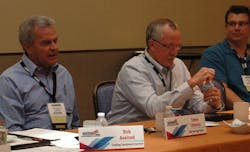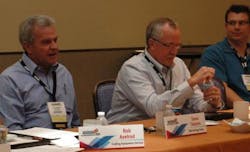On a Quest to Reduce Refrigerant Leaks
During Mechanical Systems WEEK in Schaumburg, IL, Sept. 28-30, 2012, five refrigeration contractors and five supermarket executives met with editors from Contracting Business.com and Supermarket News magazines, for in-depth discussions on the leading commercial refrigeration issues of the day. The Refrigeration Roundtable was made possible by the generous support of Danfoss, Emerson Climate Technologies, and Hill PHOENIX. This month, we provide some of their insights into the bane of the industry: refrigerant leaks.
Jon Scanlan, director, refrigeration and energy management for HyVee, said HyVee stores tend to undergo major significant remodeling every six or seven years. At that time, a distributed system is often used as a replacement, with distributed systems compressors positioned closer to the cases they serve.
“A distributed refrigeration system actually helps with phasing for the remodel, and then we would go to an HFC such as R404A at that point in time,” Scanlan said. “But at that end of the day, tight systems are still the best approach. It doesn’t matter if you’ve got R12, R502, R22, or R404A. We can’t stress enough to our contractors that we need tight systems. That’s the single most important thing.”
Scanlan added that the average leak rate in the supermarket industry, as revealed at a recent Food Marketing Institute (FMI) convention conference is just under is 25%, a rate which he finds to be unacceptable. “There are chains out there that have less than 10% leak rates. Those may be not the norm, but they sure need to be,” Scanlan said.
Howard Hehrer, senior engineer, Meijer, said the Meijer organization has been changing out stores for the past eight years. They’re replacing CFC refrigerants with various HCFC refrigerants.
“We’re kind of piggybacking onto our major case replacement initiative we had going on the last few years,” he said. “Whenever we touch a system, if it’s a candidate for a change- out, we’ll change it out at that time. We also designate a certain number of stores for changeout, outside of any remodels. We’ve changed out a little more than two-thirds of our systems so far, and we’re estimating we’re going to be done with all HCFCs in two years.”
“R404A doesn’t look to be the best choice from a global warming perspective, but as we do the change outs, the remodels, and recommissionings on all of those projects, we’re really tightening the systems up, and using distributed systems, so we’re getting our leak rates down to a pretty good level. If you keep the refrigerant contained, the global warming potential is zero.”
Steve Tibbetts, president, T&O Refrigeration, Fayetteville, GA, has an extra incentive for leak prevention: leaks are repaired on T&O’s dime.
“The chains we work for require us to pay for leak repairs and supply refrigerant, so we make sure the systems are tight, and we monitor them very closely. They’re going to hold our feet to the fire. If I was paying the bill, I would do the same thing. Mistakes do happen, and there’s only so much you can do to tighten up the system.”
Tibbetts said T&O has reduced leak rates at some chain stores from 35 or 40% down to single digits. And, while that’s an admirable achievement, he said there’s a responsibility on the part of the stores to revamp equipment as needed.
”When equipment is beyond repair, is dilapidated, or on systems with open drive-type compressors, there’s no way you can get your leak rates into single-digit range,” he claimed. “I understand some chains don’t have the money to remodel and retrofit and bring the equipment up to where it should be. No matter how good the technician is, there will be leaks. Fortunately for us, in this day and time, there’s a grocery store on every corner, and they all seem to be taking care of the product, remodeling, upgrading, taking care of their equipment, and it makes us look good. It’s a partnership, and you have to have decent stores to work in, and great mechanics in there doing it.”
Joe Gallego, manager of refrigeration and HVAC for BJ’s Wholesale Clubs, said BJ’s has generally adopted retrofit guidelines provided through the EPA’s GreenChill retrofit guidelines. (Those guidelines can be found online at: bit.ly/GreenChillGuidelines.)
“We go in a couple of weeks ahead of time to start leak checking, and at that time we start changing the oil,” Gallego explained. “On most retrofits we try to follow up with a stationary leak detection system. The prices have come way down and they’re very accurate.“We’re finding leaks at two or three parts per million (PPM) that otherwise would not have been found.”
Regarding choices in leak detection equipment, Jai Hoover, vice president, REMCO, Mechanicsburg, PA — the Contracting Business.com 2012 Commercial Refrigeration Contractor of the Year — said the company prefers Bacharach products.
“Our trucks carry the H10G and H10PM leak detectors,” he shared. “One is a plug-in version and one is a battery operated version. On the battery operated version, we give our guys a car pack, charger packthat they walk around with to use to detect on thesales floor because the battery life isn’t the greatest.We also went with the Bacharach halogen monitor. They’re very good leak detectors, very sensitive. We put 10 of those into the field, primarily with zone managers, for use with problematic stores.”
REMCO President, Ed Mattos, said one of the most important “tools” a company can provide to technicians for imporoved leak detection is sufficient time to get the job done.
“Leak checking is cost effective, and a huge part of our PM program. If you allow your techs in there, and give them the time and the right technical tools, they’ll find leaks,” Mattos said. “You can go into any store, and if you give them the right amount of time, and not rush through the process, they’ll find a leak.”

